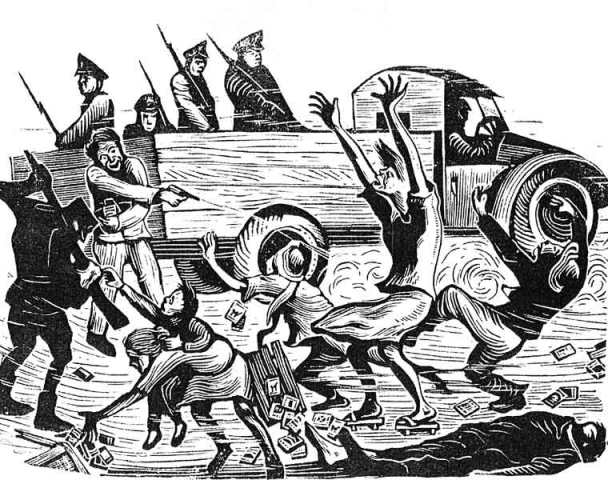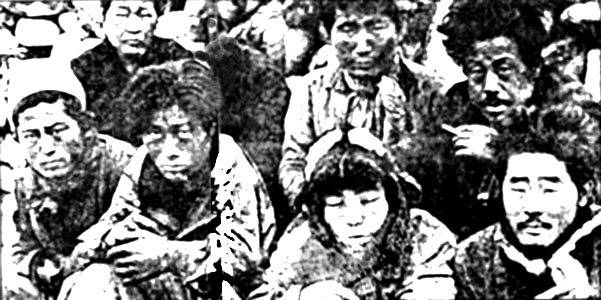| |
 |
|
| ▲ "The Terrible Inspection" woodblock print by Jun Li (Rong-zan Huang) (1916-1952). |
Massacre visited the islands of both Jeju and Taiwan in the late 1940s. And the similarities between the Taiwan 2.28 Incident and the Jeju 4.3 Incident go far beyond nomenclature.
The Japanese, decades-long colonizers, had fled both in 1945 following defeat in WWII and been usurped by the US in Jeju (Korea) and Chiang Kai Shek’s Chinese Nationalist Party (Koumintang/KMT) in Taiwan (China).
Liberation was bittersweet, bringing economic hardship, misgovernment and tens of thousands of deaths, rather than the democracy promised by the Allies’ propaganda.
Seeking reunification
Jeju’s watershed moment was March 1, 1947, when police shot locals protesting oppression and the planned 1948 elections. Jeju people presciently feared the poll would divide the country between North and South.
US and Korean authorities promptly labeled Jeju a communist threat and hardline youth brigades, some from North Korea, came from the mainland to enforce de facto martial law.
Mass arrests, torture and killings followed. A Catholic missionary says innocents were beaten by police: “And when the people pick themselves off the ground, they are leftist.”
The South Korean Labour Party then “rose up in arms for ... reunification” at 2am, April 3, 1948. Armed with rifles, grenades, and sometimes bamboo spears, 12 police boxes were attacked.
The rebels were swiftly accused of being Pyongyang operatives (the official investigation found no evidence of this) and Jeju was branded a “Red Island.”
In the years ahead mountain villagers suffered most, preyed upon both by the armed rebels, retreating to higher ground, and the authorities, killing anyone more than 5km from the coast.
The period of violence would not end until 1954. An estimated 30,000 would die from a population of 280,000.
| |
 |
|
| ▲ Jeju citizens awaiting execution in May 1948. Photo courtesy Wikimedia Commons / Public Domain |
Echoes of Formosa
Taiwan’s tale is equally harrowing. The trigger date was Feb 27, 1947 (two days before the March 1 shootings on Jeju) as a woman is arrested for selling contraband cigarettes. Police fire on the protests which immediately spring up in her support, machine-gunning many the next day (hence 2.28 Incident).
Led locally by Chief Executive Chen Yi, and from Nanjing by Director-General Chiang (the Republic of China capital relocated to Taipei in 1950), one witness said the KMT “acted as the victors and conquerors” of the island.
As riots spread, protesters demand democracy and an end to corruption in “32 Demands” presented to Chen on March 7. Before they can be sincerely considered, mainland military reinforcements arrive two days later, precipitating “an orgy of killing,” says journalist Seymour Topping.
American vice-consul George H. Kerr says locals daubed “dogs go and pigs come” on walls, a reference to one oppressor (Japan) being replaced by another (the KMT).
Some mainland Chinese are lynched by local mobs, but by May the vast majority of the estimated 10,000 victims — including many university and high school students branded communist — die at the hands of the KMT.
Martial law is promulgated in 1949, beginning the 38-year repression known as the “White Terror.”
Uncle Sam in the shadows
Both Jeju and Taiwan had the misfortune of being on the frontline in the dawning Cold War period, peoples ruptured by ideology. The role of the US is also relevant, although more so in the Jeju case.
On Jeju, says Yang Jo-Hoon, chair of Jeju 4.3 Peace Education for Jeju Provincial Office of Education, the US military was in full control until Aug 3, 1948, and even after November 1948 guided some operations.
The US expressed more unease with the KMT’s brutality, and hoped Chiang would institute reforms to diffuse dissent. At the same time, however, they warned against challenging the “constituted authority” and continued military and financial support.
Paths to reconciliation
Except for a brief democratic interlude in 1960-61, anyone challenging the official “communist insurgency” narrative of Jeju 4.3 risked arrest, while the bereaved were judged guilty by association.
Only democratization in 1987 brought the truth slowly out, and after 13 years of campaigning the National Assembly promulgated the 2000 Jeju April 3 Special Law. The official investigation followed in 2003 with a presidential apology, and funds were set aside for the peace park, museum and limited compensation and medical subsidies.
Taiwan also defeated dictatorship in 1987, but there, where the massacre was a national rather than local ordeal, the presidential apology was swifter, coming in 1995. There was also acknowledgement of the 18,000 to 28,000 victims, as well as a fund for compensation, and a memorial hall and peace park.
As of March 2015, 2,749 cases had been filed to the 2.28 investigation, including 684 deaths, 178 disappearances, and 1,419 cases of imprisonment, injury or damage to reputation. Many deaths went unreported, even to this day, and applications are open until 2017.
Jeju’s official investigation is now closed, but as of March 2014 the number of victims were 14,231, including 10,245 killed, 3578 missing, 207 disabled and 204 imprisoned. There are a total of 59,225 bereaved family members.
Open chapters
Zheng Naiwei of the 2.28 Memorial Foundation says the swift investigation, crucial in the young Taiwanese democracy gaining legitimacy, painted “a fairly complete picture” of the massacre.
Yang, chair of Jeju 4.3 Peace Education, echoes Zheng, saying that the official investigation “accomplished its crucial mission,” adding that most of its proposals have been adopted, including the National Memorial Day designation last year.
Although some activists on Jeju are pushing for a new investigation and US apology, Yang believes such an approach is counterproductive, wanting to focus on raising local awareness. “There are [still] people in Korea who have no idea about 4.3,” he says.
Partly to challenge such remaining ignorance, the East Asia Democracy, Peace and Human Rights Network was formed in 2012, comprising institutes from Korea, Taiwan and Japan, including the Jeju 4·3 Peace Foundation and 2.28 Memorial Foundation.
Domestic education is also gaining a higher profile and Jeju made 4.3 education compulsory in local primary, middle and high schools this year. In Taiwan, 2.28 education is provided not only at primary and secondary level, but also at the foremost tertiary institution, Taipei University.
Taiwanese reconciliation is more advanced in other areas too, with the president annually attending the 2.28 memorial service. Roh Moo-hyun's 2006 visit remains the only time a South Korean premier has appeared at the Jeju equivalent, with Park Geun-hye again declining to attend in person in 2015.
Scars that won't heal
As DNA tests continue to identify victims' remains, and bodies remain unclaimed and unfound on both islands, true reconciliation is still a distant hope.
For the bereaved, the memories are as vivid as ever, and will be carried to the grave. One 2.28 survivor told the BBC:
“[I]t is permanently imprinted in my memory, this incident, this massacre ... I don’t know how to describe it, it is my hand, my foot, my self — it’s my life.” |





















